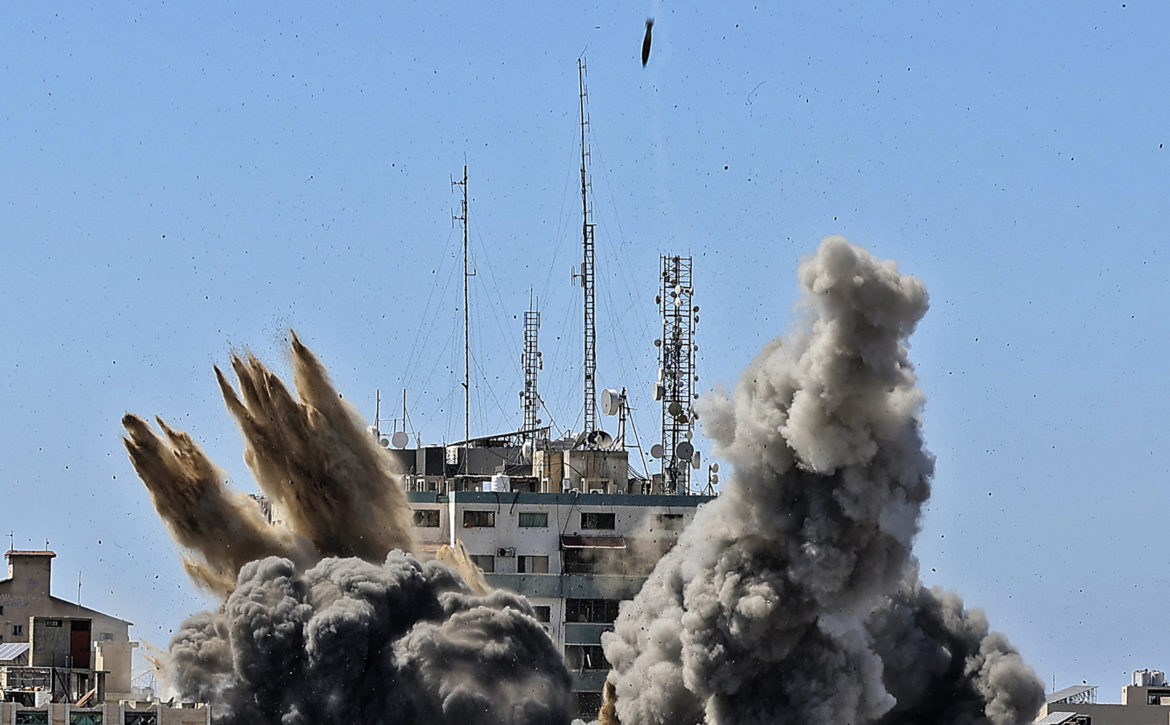
Will Israel’s Bombing of the AP Expose the Fake Neutrality of the U.S. Media’s Coverage?
There are many ways to court the world’s media, and the state of Israel has seemingly tried all of them. In recent years, that’s included a prolific use of social media—for example, cringey tweets about the Israel Defense Forces being “the most vegan army in the world”—and online influence campaigns, to the point where there’s a popular Hebrew term—hasbara—that refers to the dissemination of feel-good propaganda whitewashing Israel’s crimes against Palestinians.Over the weekend, that strategy included the Israeli government lying to the international press about invading Gaza and then bragging about it in Hebrew-language media. Lying about a Gaza ground invasion reportedly helped Israel flush out some Hamas fighters, who were killed. Later, the Israeli air force destroyed the Associated Press and Al Jazeera bureaus in Gaza, using U.S.-supplied weapons. Video circulated on social media showed reporters hurriedly gathering what equipment they could before the 11-story building came down.Destroying these media bureaus is far from the most brutal or outrageous act Israeli forces have committed during this latest round of violence. What it is, though, is a direct attack on the media’s ability to operate in Gaza—much foreign media is barred from entering the small coastal territory—and to tell the world what’s going on. It’s clear that the Israeli government has come to regard, perhaps always has regarded, the media as an adversary to be manipulated, undermined, and, when necessary, attacked. And yet many mainstream news outlets have yet to realize or accept this, instead treating Israeli military spokespeople as good-faith interlocutors. They are anything but.At a time when “both sides” narratives seem exposed for the rickety fiction they are, some prominent journalists still haven’t received the news. The worst offender may be CNN’s Brian Stelter, who, when interviewing the AP’s Sally Buzbee, repeated specious stories about AP journalists ignoring Hamas activity. “Rockets would lift off from Gaza toward Israel, and the Gaza bureau would look the other way,” said Stelter. “There’s been questions in the past about the Gaza bureau.”Later in the day, Stelter interviewed Lt. Col. Jonathan Conricus, an IDF spokesman. Peppering Conricus with requests for “proof” of Hamas presence in the media building, Stelter seemed to relish playing the role of the press defender. He never got very far. The destruction of two major foreign press bureaus would require, one would think, some elaborate justification, but the IDF spokesman turned to some very simple rhetoric: Hamas was in the building. Conricus said that the building was some sort of Hamas command center “with special technological equipment … which they used to actively fight and disrupt Israeli actions.” It was about Hamas “using civilian infrastructure” as a shield, Conricus said, repeating a common talking point about Hamas’s activity in the heavily crowded Gaza Strip: “It’s not bombing a news bureau.”Secretary of State Tony Blinken recently said he hadn’t seen any intelligence confirming Hamas activity in the building. But it doesn’t matter that Israel has furnished no evidence, or that Hamas, while considered a terrorist organization by many governments, also is the governing body of Gaza, potentially making a municipal payroll department or an electrical substation a “Hamas facility.” Nor did it matter that ordinary people lived in that building or that local reporters saw no evidence of Hamas activity. Israel, practicing its peculiar version of conscientious colonial warfare, called the building’s staff, warned them that it would soon bomb the building to rubble, and urged everyone to get out. And an hour later, it followed through on its threat, committing an act—in full view of the world—that Reporters Without Borders has since asked the International Criminal Court to investigate as a potential war crime. “We are shocked and horrified that the Israeli military would target and destroy the building housing AP’s bureau and other news organizations in Gaza,” said AP President and CEO Gary Pruitt in a statement. “The world will know less about what is happening in Gaza because of what happened today.”“Out of consideration for human life and for the people who work there, we chose to forfeit additional military gains by surprise attacking,” said IDF’s Conricus. “We choose to gain less militarily speaking by giving advance warning.”Regarding the lies about the Gaza ground invasion, Conricus described it to Stelter as a hapless error made in the fog of war. “I think that mistakes are part of the business,” he said.There have been a lot of mistakes in this conflict, which seems to resemble every other Israeli military intervention against Palestine in recent years: a grim roster of deaths, nearly all of them Palestinian, in what the media euphemistically calls “clashes”; muted criticism from Western governments; and another round of U.S. arm sales to Israel in its time of need.Put-on objectivity risks turning journalists into pawns in a dangerous game. Reporters and editors must decide whether “both sides” stenography is sufficient to cover the reality of what’s happening here. Sally Buzbee, for her part, told Brian Stelter that the AP was committed to covering the conflict from all angles. “We’re not taking sides in the actual conflict,” said Buzbee. “We believe in protecting the world’s right to know what’s going on in this conflict.” In context, it was a steely expression of determination not to let the enormity of events alter her organization’s coverage. But also: One side in this conflict—the one with nearly all of the power, influence, and military dominance—just deliberately blew up the AP’s office. As the IDF might say, the rules of engagement have changed.
Read More


